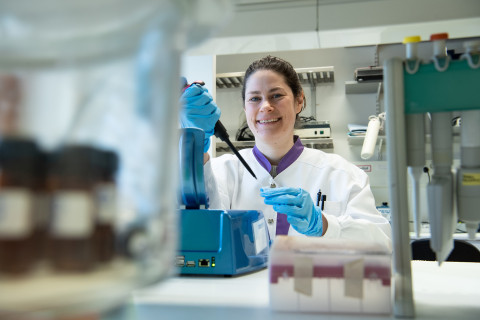Senior Researcher Astrid Subrizi from the School of Pharmacy has been awarded an Instrufoundation Fellow grant of 100 000 euros for ocular drug research. The foundation announced the grantees on 17 March.
Visual impairment and blindness are major global health issues that affect over 250 million people worldwide. Delivering drugs to their target tissues at the back of the eye is a challenge that needs to be overcome in order to successfully treat common blinding ocular diseases, such as age-related macular degeneration. “The short distance a drug must travel from the cornea at front of the eye, to the retina at the back of the eye is a little over 2 cm. Nevertheless, drugs delivered with eye drops do not reach their targets in the posterior segment of the eye, because they cannot traverse the numerous barriers, such as the cornea, the conjunctiva, and the retinal pigment epithelium, present in the eye,” Subrizi explains.
Currently, the only effective way to ensure that the required drug dose reaches its target tissues at the back of the eye is to administer the drug by direct injection into the vitreous of the eye (intravitreal injection). Besides being invasive and carrying a modest risk of severe vision-threatening complications, intravitreal injections must be carried out at a hospital on a monthly or bi-monthly basis, and can greatly inconvenience patients. Clearly, there is a compelling need to develop improved and less invasive technologies for retinal delivery.
Subrizi was awarded the Instrufoundation Fellow grant of 100 000 euros for a project tackling the exceptionally important and complex scientific problem of ocular drug delivery. “Our strategy is based on short pieces of RNA called aptamers. Like courier services, aptamers are responsible to transport the drugs safely and efficiently to the correct location inside the eye via less invasive delivery routes such as eye drops or intravenous injections,” Subrizi says.
The method used to find these targeting aptamers is called SELEX (systematic evolution of ligands by exponential enrichment). During the SELEX process, aptamers targeting ocular tissues are recovered and identified from a pool containing billions of random RNA sequences. “The Instrufoundation Fellow grant allows me to start my own research group centered on the exploitation of the SELEX technique to find novel retina targeting aptamers. The best aptamers will be developed towards products in follow-up projects. The development of a safe, effective, and minimally invasive delivery strategy would be a major improvement over the current intravitreal delivery approach.”
For further information, please contact:
Senior Researcher Astrid Subrizi, University of Eastern Finland, School of Pharmacy, tel. 0400163407, astrid.subrizi (a) uef.fi

